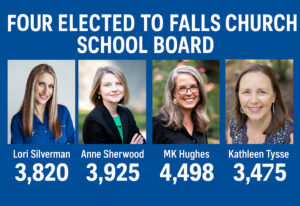Over $700 million in regional multimodal transportation infrastructure is expected to be approved tonight at the monthly meeting of the Northern Virginia Transportation Authority (NVTA) in Arlington.
For the City of Falls Church, three of the 24 projects that will be funded by tonight’s vote will have a direct and immediate impact over the next six years.
The projects here are a traffic signal synchronization initiative involving seven intersections in the City, a bus rapid transit (BRT) project centered along Route 7 (called Broad Street coming through Falls Church) running from Alexandria to Tysons, and the so-called “Ring Road” large traffic circle designed to relieve the traffic congestion at the Seven Corners intersection of Route 7 and Route 50 just yards outside the City.
None of the work on these projects will commence immediately, but tonight’s vote represents a critical point for their development over the next six years. An exception is the signal synchronization effort, designed to make it easier for eventual BRT routes to move more smoothly along Route 7, with a proposed diversion to the East Falls Church Metro station.
Not part of this package but equally important in its own right is the City’s traffic signal synchronization plan aimed at making it easier for pedestrians to navigate City streets that will impact 22 intersections here and will be kicked off with an “unveiling” at the intersection of W. Broad and N. Virginia Ave. on August 12 at 6:30 p.m.
That new software technology for that is being introduced with the help of “Smart City” technologies being crafted at Virginia Tech’s Falls Church campus.
The NVTA’s bi-annual funding initiative, which is expected to be approved, will provide for requests submitted last year by nine Northern Virginia jurisdictions and the Virginia Railway Express.
The projects underwent extensive evaluation by NVTA staff, followed by a comprehensive public comment period including a public hearing. After thorough review and community feedback, NVTA staff developed funding recommendations which were analyzed by the Technical Advisory Committee (TAC), Planning Coordination Advisory Committee (PCAC), and Planning and Programming Committee (PPC) throughout June.
Falls Church’s representative on the NVTA board, Council member David Snyder, said concerning tonight’s vote,
“The NVTA six year plan, if approved tomorrow, will provide critical funding for all transportation modes and will advance the region’s goals of sustainability, equity and safety. The City of Falls Church’s specific project will help make transit a more effective alternative and put in place a key piece of the future Route 7 Bus Rapid Transit initiative. When completed, the Route 7 BRT will move more people throughout the region who rely on transit, add a convenient option as an alternative to travel by car, serve our businesses by providing an easy and convenient way to patronize them, and improve the environment.”
While the BRT and Ring Road projects are not slated for completion for at least six years, their impact on the region will be profound. A long time already in the planning, the BRT option was chosen over light rail because of the lack of open lanes along Route 7, meaning that parts of it, including in Falls Church, will require lane sharing with vehicular traffic. Thus, the need for signal synchronization to help the buses move more smoothly through that traffic.
With $210 million, the BRT improvement will involve the widening of one lane on either side of Route 7 outside the City going into Tysons, from the intersection with Route 66 to the intersection with the Beltway.
The project will widen approximately one mile of Route 7 between I-495 and I-66 creating one lane in each direction by widening to the outside with a median. Existing lanes will be shifted outside to provide a wider median to be used for future BRT.
This project includes shared used paths on both sides. Intersection improvements will be required at five signals to facilitate the widening. Access management, including the elimination of service roads and allowing direct access from driveways to Route 7, will also be included.
The separation of vehicular traffic and the installation of shared use paths will create a safer environment that is accessible to all users.
At $122 million, the Ring Road project will have a section in Fairfax County funded running from Route 50, over the entrance to Sleepy Hollow Road and across to the other side of Route 7.
The traffic signal priority technology will be installed in the City of Falls Church to smooth the route of the BRT along Route 7. The route will run from Route 7, up N. Washington St. to the East Falls Church Metro station, then along Roosevelt Boulevard to Seven Corners.
The intersections of W. Broad St. and Lee St., W. Broad St. and Spring St., W. Broad St. and S. Virginia Ave., W. Broad St. and Little Falls St., W. Broad St. and S. Maple Ave., N. Washington St and Park Pl., and N. Washington St. and Columbia St. are included in the project.













